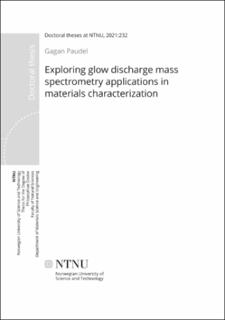| dc.contributor.advisor | Sabatino, Marisa Di | |
| dc.contributor.advisor | Roven, Hans Jørgen | |
| dc.contributor.author | Paudel, Gagan | |
| dc.date.accessioned | 2021-09-24T11:05:58Z | |
| dc.date.available | 2021-09-24T11:05:58Z | |
| dc.date.issued | 2021 | |
| dc.identifier.isbn | 978-82-326-6524-2 | |
| dc.identifier.issn | 2703-8084 | |
| dc.identifier.uri | https://hdl.handle.net/11250/2781385 | |
| dc.description.abstract | Glow discharge mass spectrometry (GDMS) relying on continuous direct current discharge source coupled to sector field mass analyzer (SF-GDMS) is popular for its ability to detect impurities in sub-ppb level. Astrum GDMS is one of the recent instruments introduced of this category. Despite of its introduction in 2010, there are only a few articles available presenting Astrum’s application and theory. Moreover, no systematic approach for determining the mode of Astrum operation, no figures of merit, relative sensitivity factors (RSFs) determination, or depth profiling are available. Therefore, the PhD thesis is focused on these limitations. Hence, broadly two applications are investigated, i.e., bulk analysis and depth profiling. To achieve this, different materials were studied, such as tantalum, silicon powder, and steel-aluminum bi-layered material.
Understanding the effect of glow discharge parameters is important as they affect quantification and, in turn, accuracy and reproducibility. Further, measurement of relative sensitivity factors (RSFs) is important to determine accurate results. Hence, firstly influence of glow discharge parameters on variation of elemental concentration was studied using a homogenous tantalum pin (˃99.5% Ta) sample using a range of current and voltage settings (0.5 – 5 mA at 1 kV and 0.6 – 1.5 kV at 3 mA). The variation in concentration change was related to unequal change of absolute intensity of elemental impurities as compared to that of tantalum. Hence, RSFs vary with glow discharge parameters. Interestingly, this work hinted that measurement of discharge gas and other gaseous elements can contribute to optimization of discharge parameters before determining RSFs.
This followed analysis of silicon powder after pressing against high purity indium sheets. Various impurity elements were analyzed using glow discharge current and voltage settings of 1 – 3.5 mA and 1 – 1.4 kV, respectively. Further, argon was quantified using current and voltage settings of 1– 5 mA and 1.2 – 1.6 kV, respectively. Remarkably the concentration of most of the impurity elements and quantification of argon is found to vary less in range of 2 – 3 mA and 1.2 – 1.4 kV. This observation is consistent with argon and oxygen quantification using flat silicon and nitrogen quantification using aluminum flat samples. Further, gaseous elements such as carbon, oxygen, nitrogen and argon present in tantalum pin and nitrogen present in aluminum pin followed the same pattern. Hence, measurement of gaseous elements and discharge gas can contribute to RSFs determination in other matrices also. Finally, relative sensitivity factors of 16 impurity elements valuable for solar cell silicon application are determined using certified silicon standard.
For depth profiling application, the glow discharge settings leading to optimum crater shapes are determined using tantalum flat samples. The results of the study indicate that current to voltage ratio in range of 0.2 – 0.35 kV/mA results into flat craters in tantalum. Hence, five different combinations of current and voltage are found namely, (i) 2 mA, 0.6 kV; (ii) 2.3 mA, 0.7 kV; (iii) 3 mA, 0.8 kV; (iv) 4 mA, 0.9 kV and (v) 5 mA, 1 kV. Further, the sputtering rates increase with increasing current and voltage settings. Sputtering of tantalum of small and large grains indicated that differential sputtering of grains of different crystal orientation leads to crater bottom roughness.
This followed analysis of steel-aluminum bi-layered material where firstly crater shape optimization using base aluminum material was carried out using similar approach as with tantalum flat sample. The depth profiling of chromium and nickel is carried out in non-heated and heat treated (at 400 °C for 30 min) steel-aluminum bi-layered joints. The analysis was performed using glow discharge current and voltage of 5 mA and 0.75 kV, respectively. Using Astrum GDMS, the diffusion behavior of trace alloying elements such as chromium and nickel at the aluminum-steel interface was investigated. The results of the work indicate enrichment of both impurity elements for both sets of samples at the steel-aluminum interface. The heat-treated sample demonstrated higher content of chromium and nickel at the interface as well as formation of thin intermetallic layer formation. Further, chromium precipitates along with iron were found in the aluminum layer correlating with high chromium content in the aluminum layer. | en_US |
| dc.language.iso | eng | en_US |
| dc.publisher | NTNU | en_US |
| dc.relation.ispartofseries | Doctoral theses at NTNU;2021:232 | |
| dc.relation.haspart | Paper 1: Paudel, Gagan; Kasik, Martin; Di Sabatino Lundberg, Marisa. Investigation of the intensity dependence of glow discharge mass spectrometry quantification on the discharge parameters. Journal of Analytical Atomic Spectrometry 2019 ;Volum 34.(9) s. 1829-1837 https://doi.org/10.1039/C9JA00116F | en_US |
| dc.relation.haspart | Paper 2:
Paudel, Gagan; Di Sabatino Lundberg, Marisa.
Quantification of discharge gas to optimize discharge parameters for relative sensitivity factors(RSFs) determination by slow-flow glow discharge mass spectrometry(GDMS).
Journal of Analytical Atomic Spectrometry 2020 ;Volum 35.(11) s. 2748-2757
https://doi.org/10.1039/D0JA00281J | |
| dc.relation.haspart | Paper 3: Paudel, Gagan; Khromov, Sergey; Kasik, Martin; Roven, Hans Jørgen; Di Sabatino Lundberg, Marisa. Influence of polycrystalline material on crater shape optimization and roughness using low power/low-pressure direct-current glow discharge mass spectrometry. Journal of Analytical Atomic Spectrometry 2020 ;Volum 35.(7) s. 1450-1457
https://doi.org/10.1039/D0JA00055H | |
| dc.relation.haspart | Paper 4:
Paudel, G., Langelandsvik, G., Khromov, S., Arbo S.M., Westermann, I., Roven, H.J.,
and Di Sabatino, M. Depth profiling at a steel-aluminum interface using slow-flow direct
current glow discharge mass spectrometry | |
| dc.title | Exploring glow discharge mass spectrometry applications in materials characterization | en_US |
| dc.type | Doctoral thesis | en_US |
| dc.subject.nsi | VDP::Technology: 500 | en_US |
| dc.subject.nsi | VDP::Technology: 500::Materials science and engineering: 520 | en_US |

